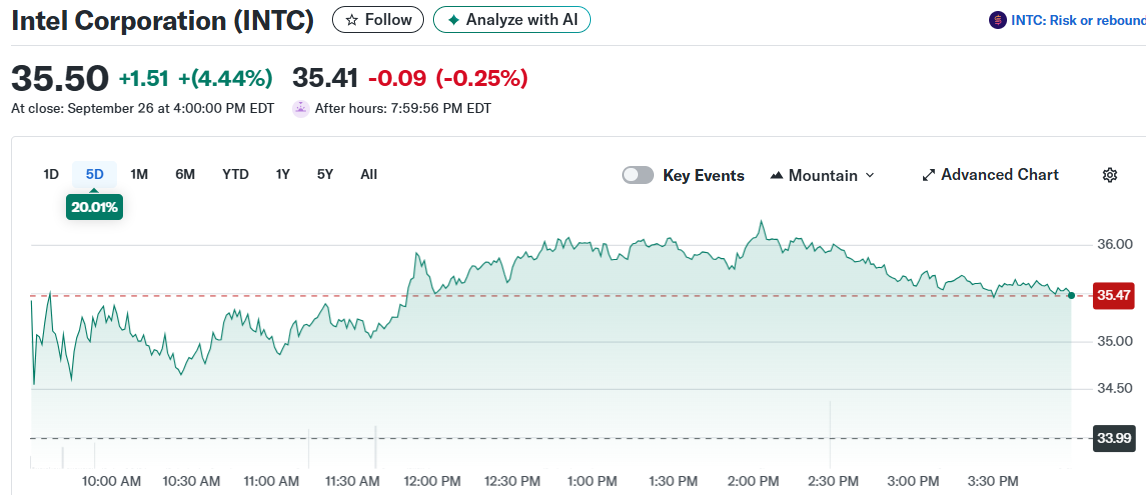Intel (INTC) Stock Surges on Trump Tariff News and Nvidia Partnership - Here’s Why It Matters
Intel shares rocket upward as political winds shift and tech alliances reshape the semiconductor landscape.
The Catalyst Behind the Rally
Trump's latest tariff announcements sent shockwaves through tech sectors—but Intel caught a bullish wave instead of getting crushed. Meanwhile, their newly unveiled partnership with Nvidia signals a strategic pivot that's got Wall Street buzzing.
Market Mechanics at Play
Traders piled into INTC as tariff protections promised to shield domestic chipmakers from foreign competition. The Nvidia collab adds fuel to the fire, positioning Intel for a comeback in the AI hardware race they'd been losing.
Why This Move Changes Everything
This isn't just another corporate handshake—it's a survival maneuver in an industry where missing the AI boom means becoming irrelevant overnight. Intel's playing catch-up, but they're using political tailwinds to do it.
Of course, Wall Street analysts will claim they saw this coming all along—right after they finish downgrading their price targets from last week's predictions.
TLDR
- President Trump considering new tariffs on chip companies that manufacture more overseas than in the US
- Companies must maintain at least 1-to-1 ratio of domestic to international chip production to avoid penalties
- Nvidia announced $5 billion investment in Intel at $23.28 per share, a 25% discount to current price
- Federal government took 10% stake in Intel last month as part of national security strategy
- Intel and Nvidia partnering to develop AI data center and PC products using integrated architectures
Intel stock surged Friday as investors digested news about potential new semiconductor tariffs from the TRUMP administration. The chipmaker’s shares climbed 5.5% following a Wall Street Journal report about upcoming trade policies.

President Trump is considering tariffs on semiconductor companies that rely too heavily on foreign manufacturing. The proposed policy WOULD penalize companies that don’t maintain at least a 1-to-1 ratio of chips made domestically versus internationally.
This MOVE aligns with the administration’s push to boost domestic chip production. The policy serves as part of Trump’s broader national security strategy and efforts to bring manufacturing back to American shores.
The tariff news comes just weeks after another major development for Intel. Last month, the federal government secured a 10% stake in the struggling chipmaker as part of a broader support package.
Intel’s recent challenges stem from falling behind in the generative AI boom. The company that once dominated U.S. chip manufacturing has struggled to keep pace with rapid technological changes.
The chipmaker has undergone extensive restructuring efforts. Management implemented major layoffs and balance sheet stabilization measures to address declining revenues and profits.
New Partnership Brings Fresh Investment
Earlier this month, Nvidia announced a $5 billion investment in Intel shares. The graphics chip giant will purchase stock at $23.28 per share, representing a 25% discount to current trading prices.
The Nvidia deal includes more than just financial investment. Both companies plan to develop multiple generations of custom data center and PC products together.
The partnership will integrate Nvidia’s AI expertise with Intel’s personal computer market position. Intel will manufacture x86 system-on-chips that incorporate Nvidia RTX GPU chiplets using NVIDIA NVLink technology.
This collaboration transforms Intel into one of Nvidia’s largest customers. The arrangement provides Intel with both capital and a major business relationship.
Market Response and Trading Activity
Intel shares have shown strong momentum recently. Friday’s trading volume reached 268 million shares, more than double the average daily volume of 114 million.
The stock hit a 52-week high of $36.30 during Friday’s session. Year-to-date performance remains mixed as the company works through its turnaround efforts.
Market participants appear optimistic about Intel’s strategic positioning. The combination of government support, Nvidia partnership, and potential tariff protection creates multiple tailwinds.
Intel’s gross margin currently stands at 29.76% as the company manages through its restructuring phase. The chipmaker maintains a market capitalization of approximately $166 billion.
Friday’s session saw Intel shares trade between $34.50 and $36.30. The stock closed at $35.53, up $1.54 or 4.53% for the day.

